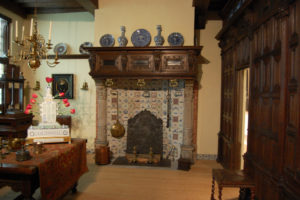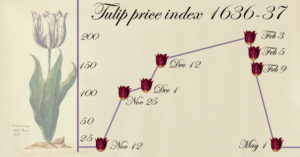Let’s talk bourbon and tulips.
I popped into the Philadelphia Art Museum recently to browse an exhibition and found myself wandering the European Art wing. One of the historically reconstructed rooms is originally from the Netherlands (built in the early 17th century), a part of a brewery compound on the River Spaarne in Haarlem. On the antique table in the middle of the room was a strange looking white, porcelain vase with blue, painted decorations. At the bottom of the vase, in script, it says “Irrational Exuberance.”  It took me a minute to realize that this was a tulip vase and the reference was to the Netherlands’ tulip mania in the 1630s. This vase is a perfect addition to this reconstructed room because Haarlem (the town where this room is from) was the center of the 1637 Tulipmania collapse. If you are not familiar with the tulip mania of the Dutch Golden Age, let me help paint you a picture…
It took me a minute to realize that this was a tulip vase and the reference was to the Netherlands’ tulip mania in the 1630s. This vase is a perfect addition to this reconstructed room because Haarlem (the town where this room is from) was the center of the 1637 Tulipmania collapse. If you are not familiar with the tulip mania of the Dutch Golden Age, let me help paint you a picture…
Imagine a country in the midst of an economic boom. The newly wealthy are excited about a new status symbol with very limited availability. Just about thirty years before, the only folks interested in said product were a few educated tradespeople and scientists. Now, buyers were drawn to this product like flies to honey! Though new batches don’t fully mature for 7-12 years, that doesn’t slow demand. There are many different varieties made available with extravagant names like “Semper Augustus”, “Alexander the Great” and “Admiral van der Eijck”. The product was being bought and sold at higher and higher prices by investors and speculators. Additionally, because the rise in prices occurred after the product was fully matured, producers would not have had an opportunity to increase production in response to price. The country’s banks were creating a bubble, the citizens were struggling with societal unrest and people are beginning to doubt the value of a product that the wealthy were very eager to buy. Still with me?
Are we talking about tulips or bourbon? There is a great deal of debate around what caused that infamous “Tulip Mania” and why the Dutch tulip market came crashing down in 1637, but there is little debate about it being a learning experience for modern economies. Bourbon and tulips are obviously limited in their comparisons, but it’s not too far-fetched to see some value similarities. A flowering plant cannot be sold before it has bloomed in the same way that a whiskey cannot be sold before it is aged, and any number of problems can arise during that time to alter the final product. This creates the need to speculate their values. Tulip seeds take 7-12 years to become flowering bulbs. High priced bourbons need at least that long to mature in oak. At the height of the tulip craze, one bulb was valued at nearly 2500 florin, the equivalent of $33,000 today. (A skilled laborer might earn 150 florins a year.) The new Pappy Van Winkle 25 year old bottling is now demanding up to $15,000. When you consider that the Pappy Van Winkle 23 year old was retailing at $250 in 2007, and now can demand as much as $5000 today, you have to consider that America might be experiencing its own “irrational exuberance”. (This expression is now often connected to Alan Greenspan’s description of the dot-com bubble, but as you can see, the quote did not originate with him.)

The Dutch were dramatically raising the value of tulip bulbs in a time of income inequality and political unrest almost 400 years ago.
“Many individuals grew suddenly rich. A golden bait hung temptingly out before the people, and, one after the other, they rushed to the tulip marts, like flies around a honey-pot. Every one imagined that the passion for tulips would last for ever, and that the wealthy from every part of the world would send to Holland, and pay whatever prices were asked for them. The riches of Europe would be concentrated on the shores of the Zuyder Zee, and poverty banished from the favoured clime of Holland. Nobles, citizens, farmers, mechanics, seamen, footmen, maidservants, even chimney sweeps and old clotheswomen, dabbled in tulips.”- Charles McCay (1841)
Tulips are beautiful, but they are just flowers. Traders were selling the same bulb ten times in one day, and those bulbs never changed hands. Buyers became irrational and began buying and selling for profit that had nothing to do with the tulips themselves. Both bourbon and tulips have limited utility. Their value is based on subjective evaluation and societal trends, so there is no real foundation beneath either’s cost to the consumer.
Bourbon is wonderful, but it’s just a drink, right? If consumers can keep their heads in these modern times of unrest and income inequality, perhaps bourbon can maintain its value and remain affordable to the people that made it valuable to begin with. These things do have an historic tendency of getting carried away…

